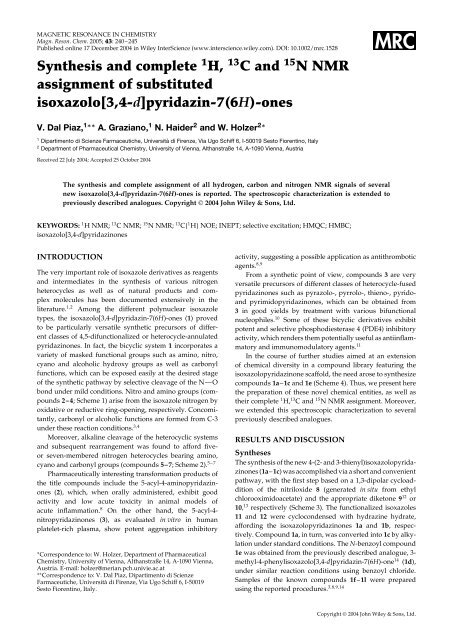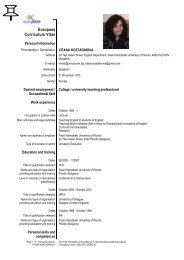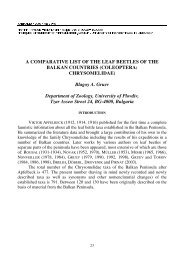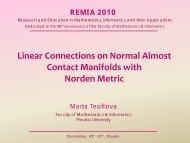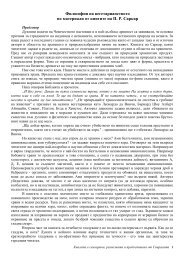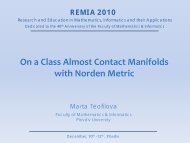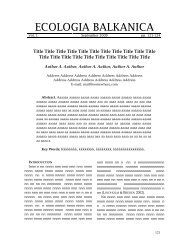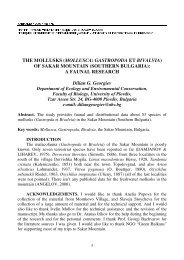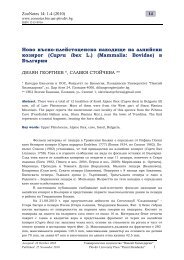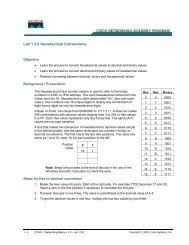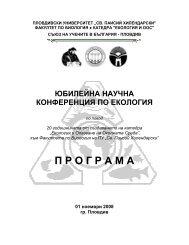Synthesis and complete 1H, 13C and 15N NMR assignment of ...
Synthesis and complete 1H, 13C and 15N NMR assignment of ...
Synthesis and complete 1H, 13C and 15N NMR assignment of ...
- No tags were found...
Create successful ePaper yourself
Turn your PDF publications into a flip-book with our unique Google optimized e-Paper software.
MAGNETIC RESONANCE IN CHEMISTRY<br />
Magn. Reson. Chem. 2005; 43: 240–245<br />
Published online 17 December 2004 in Wiley InterScience (www.interscience.wiley.com). DOI: 10.1002/mrc.1528<br />
<strong>Synthesis</strong> <strong>and</strong> <strong>complete</strong> 1 H, 13 C<strong>and</strong> 15 N<strong>NMR</strong><br />
<strong>assignment</strong> <strong>of</strong> substituted<br />
isoxazolo[3,4-d]pyridazin-7(6H)-ones<br />
V. Dal Piaz, 1∗∗ A. Graziano, 1 N. Haider 2 <strong>and</strong> W. Holzer 2∗<br />
1 Dipartimento di Scienze Farmaceutiche, Università di Firenze, Via Ugo Schiff 6, I-50019 Sesto Fiorentino, Italy<br />
2 Department <strong>of</strong> Pharmaceutical Chemistry, University <strong>of</strong> Vienna, Althanstraße 14, A-1090 Vienna, Austria<br />
Received 22 July 2004; Accepted 25 October 2004<br />
The synthesis <strong>and</strong> <strong>complete</strong> <strong>assignment</strong> <strong>of</strong> all hydrogen, carbon <strong>and</strong> nitrogen <strong>NMR</strong> signals <strong>of</strong> several<br />
new isoxazolo[3,4-d]pyridazin-7(6H)-ones is reported. The spectroscopic characterization is extended to<br />
previously described analogues. Copyright © 2004 John Wiley & Sons, Ltd.<br />
KEYWORDS: 1 H<strong>NMR</strong>; 13 C<strong>NMR</strong>; 15 N<strong>NMR</strong>; 13 Cf 1 Hg NOE; INEPT; selective excitation; HMQC; HMBC;<br />
isoxazolo[3,4-d]pyridazinones<br />
INTRODUCTION<br />
The very important role <strong>of</strong> isoxazole derivatives as reagents<br />
<strong>and</strong> intermediates in the synthesis <strong>of</strong> various nitrogen<br />
heterocycles as well as <strong>of</strong> natural products <strong>and</strong> complex<br />
molecules has been documented extensively in the<br />
literature. 1,2 Among the different polynuclear isoxazole<br />
types, the isoxazolo[3,4-d]pyridazin-7(6H)-ones (1) proved<br />
to be particularly versatile synthetic precursors <strong>of</strong> different<br />
classes <strong>of</strong> 4,5-difunctionalized or heterocycle-annulated<br />
pyridazinones. In fact, the bicyclic system 1 incorporates a<br />
variety <strong>of</strong> masked functional groups such as amino, nitro,<br />
cyano <strong>and</strong> alcoholic hydroxy groups as well as carbonyl<br />
functions, which can be exposed easily at the desired stage<br />
<strong>of</strong> the synthetic pathway by selective cleavage <strong>of</strong> the N—O<br />
bond under mild conditions. Nitro <strong>and</strong> amino groups (compounds<br />
2–4; Scheme 1) arise from the isoxazole nitrogen by<br />
oxidative or reductive ring-opening, respectively. Concomitantly,<br />
carbonyl or alcoholic functions are formed from C-3<br />
under these reaction conditions. 3,4<br />
Moreover, alkaline cleavage <strong>of</strong> the heterocyclic systems<br />
<strong>and</strong> subsequent rearrangement was found to afford fiveor<br />
seven-membered nitrogen heterocycles bearing amino,<br />
cyano <strong>and</strong> carbonyl groups (compounds 5–7;Scheme2). 5–7<br />
Pharmaceutically interesting transformation products <strong>of</strong><br />
the title compounds include the 5-acyl-4-aminopyridazinones<br />
(2), which, when orally administered, exhibit good<br />
activity <strong>and</strong> low acute toxicity in animal models <strong>of</strong><br />
acute inflammation. 8 On the other h<strong>and</strong>, the 5-acyl-4-<br />
nitropyridazinones (3), as evaluated in vitro in human<br />
platelet-rich plasma, show potent aggregation inhibitory<br />
Ł Correspondence to: W. Holzer, Department <strong>of</strong> Pharmaceutical<br />
Chemistry, University <strong>of</strong> Vienna, Althanstraße 14, A-1090 Vienna,<br />
Austria. E-mail: holzer@merian.pch.univie.ac.at<br />
ŁŁ Correspondence to: V. Dal Piaz, Dipartimento di Scienze<br />
Farmaceutiche, Università di Firenze, Via Ugo Schiff 6, I-50019<br />
Sesto Fiorentino, Italy.<br />
activity, suggesting a possible application as antithrombotic<br />
agents. 8,9<br />
From a synthetic point <strong>of</strong> view, compounds 3 are very<br />
versatile precursors <strong>of</strong> different classes <strong>of</strong> heterocycle-fused<br />
pyridazinones such as pyrazolo-, pyrrolo-, thieno-, pyrido<strong>and</strong><br />
pyrimidopyridazinones, which can be obtained from<br />
3 in good yields by treatment with various bifunctional<br />
nucleophiles. 10 Some <strong>of</strong> these bicyclic derivatives exhibit<br />
potent <strong>and</strong> selective phosphodiesterase 4 (PDE4) inhibitory<br />
activity, which renders them potentially useful as antiinflammatory<br />
<strong>and</strong> immunomodulatory agents. 11<br />
In the course <strong>of</strong> further studies aimed at an extension<br />
<strong>of</strong> chemical diversity in a compound library featuring the<br />
isoxazolopyridazinone scaffold, the need arose to synthesize<br />
compounds 1a–1c <strong>and</strong> 1e (Scheme 4). Thus, we present here<br />
the preparation <strong>of</strong> these novel chemical entities, as well as<br />
their <strong>complete</strong> 1 H, 13 C<strong>and</strong> 15 N <strong>NMR</strong> <strong>assignment</strong>. Moreover,<br />
we extended this spectroscopic characterization to several<br />
previously described analogues.<br />
RESULTS AND DISCUSSION<br />
Syntheses<br />
The synthesis <strong>of</strong> the new 4-(2- <strong>and</strong> 3-thienyl)isoxazolopyridazinones<br />
(1a–1c) was accomplished via a short <strong>and</strong> convenient<br />
pathway, with the first step based on a 1,3-dipolar cycloaddition<br />
<strong>of</strong> the nitriloxide 8 (generated in situ from ethyl<br />
chlorooximidoacetate) <strong>and</strong> the appropriate diketone 9 12 or<br />
10, 13 respectively (Scheme 3). The functionalized isoxazoles<br />
11 <strong>and</strong> 12 were cyclocondensed with hydrazine hydrate,<br />
affording the isoxazolopyridazinones 1a <strong>and</strong> 1b, respectively.<br />
Compound 1a,inturn,wasconvertedinto1c by alkylation<br />
under st<strong>and</strong>ard conditions. The N-benzoyl compound<br />
1e was obtained from the previously described analogue, 3-<br />
methyl-4-phenylisoxazolo[3,4-d]pyridazin-7(6H)-one 14 (1d),<br />
under similar reaction conditions using benzoyl chloride.<br />
Samples <strong>of</strong> the known compounds 1f–1l were prepared<br />
using the reported procedures. 3,8,9,14<br />
Copyright © 2004 John Wiley & Sons, Ltd.
<strong>Synthesis</strong> <strong>of</strong> substituted isoxazolo[3,4-d]pyridazin-7(6H)-ones 241<br />
Scheme 1. Reductive <strong>and</strong> oxidative isoxazole ring cleavage in<br />
isoxazolo[3,4-d]pyridazin-7(6H)-ones (1).<br />
Scheme 3. <strong>Synthesis</strong> <strong>of</strong> new isoxazolo[3,4-d]pyridazin-7(6H)-<br />
ones 1a–1c <strong>and</strong> 1e.<br />
Scheme 4. Structure <strong>and</strong> numbering scheme <strong>of</strong> isoxazolo[3,4-<br />
d]pyridazin-7(6H)-ones 1a–1l.<br />
Scheme 2. Ring transformations <strong>of</strong> 1 under alkaline conditions.<br />
1 H<strong>NMR</strong>, 13 C<strong>NMR</strong><strong>and</strong> 15 N <strong>NMR</strong> spectral<br />
<strong>assignment</strong>s<br />
The structures <strong>and</strong> numbering scheme <strong>of</strong> the newly synthesized<br />
compounds 1a–1c, 1e <strong>and</strong> the known isoxazolo[3,4-<br />
d]pyridazin-7(6H)-ones 1d <strong>and</strong> 1f–1l are given in Scheme 4.<br />
The 1 H <strong>NMR</strong> data are listed in Table 1, 13 C chemical shifts<br />
are presented in Table 2, selected 13 C 1 H spin coupling constants<br />
are given in Table 3 <strong>and</strong> the 15 N chemical shifts are<br />
summarized in Table 4.<br />
The 1 H <strong>NMR</strong> spectra <strong>of</strong> compounds 1a–1l were simple<br />
to analyse because they contain only a few signals. C-<br />
Methyl singlets (C3-CH 3 , C4-CH 3 , υ 2.41–2.90) could be<br />
distinguished from N-methyl lines (N6-CH 3 , υ 3.55–3.69) on<br />
the basis <strong>of</strong> chemical shift considerations.<br />
In compounds 1f, 1g <strong>and</strong> 1h two C-methyl groups are<br />
present, which were discriminated via long-range INEPT<br />
experiments with selective excitation. Thus, for instance,<br />
selective excitation <strong>of</strong> the C3-CH 3 transition in 1g (υ 2.84)<br />
revealed the characteristic downfield signal <strong>of</strong> C-3 (υ 171.7) as<br />
well as that <strong>of</strong> C-3a (υ 112.0), whereas in a similar experiment<br />
the C4-CH 3 protons exhibited correlations to C-3a <strong>and</strong> to C-4<br />
(υ 140.1). Either HMQC or one-dimensional HETCOR spectra<br />
enabled us to identify the carbon atoms directly attached to<br />
the unambiguously assigned proton resonances. However,<br />
the main task in analysis <strong>of</strong> the 13 C <strong>NMR</strong> spectra consisted <strong>of</strong><br />
<strong>assignment</strong> <strong>of</strong> the numerous quaternary carbon atoms. This<br />
could be achieved mainly by a series <strong>of</strong> long-range INEPT<br />
experiments with selective excitation, optimized for a 13 C 1 H<br />
coupling <strong>of</strong> 6–8 Hz (outlined in Scheme 5 for 1a) aswell<br />
as on the basis <strong>of</strong> coupling information from the fully 1 H-<br />
coupled 13 C <strong>NMR</strong> spectra. With compounds 1a, 1b, 1d <strong>and</strong><br />
Copyright © 2004 John Wiley & Sons, Ltd. Magn. Reson. Chem. 2005; 43: 240–245
242 V. Dal Piaz et al.<br />
Table 1. The 1 H <strong>NMR</strong> chemical shifts (υ, ppm) <strong>of</strong> compounds 1a–1l (in DMSO-d 6 )<br />
Compound H <strong>of</strong> R 1 H<strong>of</strong>R 2 H<strong>of</strong>R 3<br />
1a 2.74 7.73 (H-5 0 ), 7.56 (H-3 0 ), 7.21 (H-4 0 ) a 12.67<br />
1b 2.62 7.92 (H-2 0 ), 7.71 (H-5 0 ), 7.39 (H-4 0 ) b 12.38<br />
1c 2.75 7.76 (H-5 0 ), 7.57 (H-3 0 ), 7.22 (H-4 0 ) c 4.08 (CH 2 ), 1.28 (CH 3 )<br />
1d 2.49 7.60 (o-H), 7.53 (m-H, p-H) 12.66<br />
1e 2.53 7.59 (o-H), 7.54 (m-H, p-H) 8.01 (o-H), 7.73 (p-H), 7.57 (m-H)<br />
1f 2.84 2.41 12.19<br />
1g 2.84 2.43 3.55<br />
1h 2.90 2.50 7.51 (o-H, m-H), 7.39 (p-H)<br />
1i 2.50 7.61 (o-H), 7.54 (m-H, p-H) 3.67<br />
1j 2.83 (CH 2 ), 1.07 (CH 3 ) 7.61 (o-H), 7.55 (m-H, p-H) 4.12 (CH 2 ), 1.29 (CH 3 ) d<br />
1k 2.57 8.76 (H-2,6), 7.64 (H-3,5) 3.69<br />
1l 2.51 7.63 (o-H), 7.54 (m-H, p-H) 4.08 (NCH 2 ), e 1.72 (NCH 2 CH 2 ), 1.33 (CH 2 CH 3 ), 0.89 (CH 3 ) f<br />
a3 J⊲H-3 0 , H-4 0 ⊳ D 3.7Hz, 4 J⊲H-3 0 , H-5 0 ⊳ D 1.2Hz, 3 J⊲H-4 0 , H-5 0 ⊳ D 5.<strong>1H</strong>z.<br />
b3 J⊲H-4 0 , H-5 0 ⊳ D 5.0Hz, 4 J⊲H-2 0 , H-4 0 ⊳ D 1.2Hz, 4 J⊲H-2 0 , H-5 0 ⊳ D 2.9Hz.<br />
c3 J⊲H-3 0 , H-4 0 ⊳ D 3.7Hz, 4 J⊲H-3 0 , H-5 0 ⊳ D 1.2Hz, 3 J⊲H-4 0 , H-5 0 ⊳ D 5.<strong>1H</strong>z.<br />
d3 J⊲CH 3 , CH 2 ⊳ D 7.<strong>1H</strong>z.<br />
e3 J⊲NCH 2 , CH 2 ⊳ D 7.2Hz.<br />
f3 J⊲CH 3 , CH 2 ⊳ D 7.3Hz.<br />
Table 2. The 13 C <strong>NMR</strong> chemical shifts (υ, ppm) <strong>of</strong> compounds 1a–1l (in DMSO-d 6 )<br />
Compound C-3 C-3a C-4 C-7 C-7a C <strong>of</strong> R 1 C<strong>of</strong>R 2 C<strong>of</strong>R 3<br />
1a 171.0 110.4 136.8 153.3 151.9 14.3 135.7 (2 0 ), 129.0 (3 0 ),<br />
128.5 (5 0 ), 127.7 (4 0 )<br />
1b 171.1 111.0 138.3 153.5 151.9 13.8 134.7 (3 0 ), 127.6 (4 0 ),<br />
127.0 (5 0 ), 126.7 (2 0 )<br />
1c 171.3 110.3 136.4 151.7 151.8 14.3 135.4 (2 0 ), 129.3 (3 0 ),<br />
128.8 (5 0 ), 127.7 (4 0 )<br />
1d 171.0 110.9 142.5 153.5 152.0 13.7 133.8 (1), 129.6 (4),<br />
128.5 (3,5), 128.4 (2,6)<br />
1e 171.8 111.1 143.3 152.9 152.5 13.6 132.9 (1), 130.2 (4),<br />
128.6 (3,5), 128.5 (2,6)<br />
—<br />
—<br />
44.6 (CH 2 ), 13.3 (CH 3 )<br />
—<br />
170.2 (C O), 134.5 (4),<br />
131.7 (1), 130.6 (2,6), 128.9<br />
(3,5)<br />
1f 171.3 112.0 140.4 153.7 151.6 12.8 18.7 —<br />
1g 171.7 112.0 140.1 152.4 151.3 12.8 18.7 37.5<br />
1h 171.9 111.9 140.9 152.4 152.1 12.9 18.9 140.9 (1), 128.6 (3,5), 127.6<br />
(4), 126.2 (2,6)<br />
1i 171.3 111.0 141.9 152.3 151.7 13.7 133.4 (1), 129.8 (4), 38.0<br />
128.5 (3,5), 128.4 (2,6)<br />
1j 175.2 110.3 142.2 151.8 151.8 20.9 (CH 2 ), 11.1 (CH 3 ) 133.9 (1), 129.8 (4), 44.6 (CH 2 ), 13.3 (CH 3 )<br />
128.5 (3,5), 128.2 (2,6)<br />
1k 171.3 110.5 139.6 152.4 151.7 13.9 150.1 (2,6), 140.8 (4),<br />
122.8 (3,5)<br />
38.1<br />
1l 171.3 110.8 142.0 152.1 151.8 13.7 133.5 (1), 129.8 (4),<br />
128.5 (3,5), 128.4 (2,6)<br />
49.0 (NCH 2 ), 29.9<br />
(NCH 2 CH 2 ), 19.3 (CH 2 CH 3 ),<br />
13.5 (CH 3 )<br />
1f, characterized by an NH moiety (R 3 D H), the signal due<br />
to C-7 could be identified independently by heteronuclear<br />
13 Cf 1 Hg NOE difference experiments (irradiation <strong>of</strong> the NH<br />
resonance enhanced the line <strong>of</strong> the adjacent C-7 carbon atom).<br />
In cases when no unequivocal <strong>assignment</strong> <strong>of</strong> 13 C 1 H coupling<br />
constants was possible (e.g. within the thiophene system<br />
<strong>of</strong> compounds 1a–1c), two-dimensional (υ,J) long-range<br />
INEPT experiments with selective excitation were applied.<br />
Interestingly, the signal due to C-7a also showed a quartet<br />
splitting (J D 1 Hz, after resolution enhancement) in the<br />
1 H-coupled 13 C <strong>NMR</strong> spectra. Because this splitting was<br />
observed in compounds carrying no methyl groups attached<br />
toC-4orN-6,itmustoriginatefroma 4 J coupling to the 3-CH 3<br />
protons. This finding was confirmed by the observation that<br />
Copyright © 2004 John Wiley & Sons, Ltd. Magn. Reson. Chem. 2005; 43: 240–245
<strong>Synthesis</strong> <strong>of</strong> substituted isoxazolo[3,4-d]pyridazin-7(6H)-ones 243<br />
Table 3. Selected 13 C 1 H spin coupling constants (Hz) <strong>of</strong> compounds 1a–1l (in DMSO-d6)<br />
Compound<br />
2 J(C3, 3-CH 3)<br />
3 J(C3a, 3-CH 3)<br />
4 J(C7a, 3-CH 3)<br />
1 J(3-CH 3) J <strong>of</strong> R 2 J <strong>of</strong> R 3 Other couplings<br />
1a 7.2 2.7 1.1 131.8 a<br />
—<br />
1b 7.2 2.7 1.1 131.7 b<br />
—<br />
1c 7.2 2.8 1.0 131.8 c 1<br />
J⊲NCH 2⊳ D 141.3<br />
2 J⊲NCH 2, CH3⊳ D 4.6<br />
1 J⊲CH 3⊳ D 127.7<br />
2 J⊲CH 3, CH2⊳ D 3.4<br />
3 J(C7, NCH 2) D 2.3<br />
1d 7.1 2.7 1.1 131.7 —<br />
1e 7.2 2.7 1.0 131.9<br />
1f 7.1 2.9 1.1 131.5 1<br />
J D 128.9⊲CH<br />
3⊳ — 3<br />
J(C3a, 4-CH 3) D 2.9<br />
1g 7.1 2.9 1.0 131.6 1<br />
J D 129.1⊲CH<br />
3⊳ 1<br />
J⊲CH<br />
3⊳ D 140.7 3<br />
J(C3a, 4-CH 3) D 2.9<br />
1h 7.1 2.9 1.0 131.6 1<br />
J D 129.3⊲CH<br />
3⊳ 3<br />
J(C3a, 4-CH 3) D 2.9<br />
1i 7.2 2.6 1.1 131.7 1<br />
J⊲CH<br />
3⊳ D 141.0 3<br />
J(C7, NCH 3) D 2.2<br />
1j 7.4 (C3, 3-CH2) 2.1 (C3a, 3-CH2) 1.0 (C7a, 3-CH2) 131.7 (3-CH2), 129.1 (CH3) 1<br />
J⊲NCH 2⊳ D 141.2<br />
2 J⊲NCH 2, CH3⊳ D 4.6<br />
1 J⊲CH 3⊳ D 127.6<br />
2 J⊲CH 3, CH2⊳ D 3.4<br />
3 J(C7, NCH 2) D 2.5<br />
1k 7.2 2.7 131.9 1<br />
J⊲CH<br />
3⊳ D 141.2 3<br />
J(C7, NCH 3) D 2.1<br />
1l 7.2 2.7 131.8 1<br />
J⊲NCH<br />
2⊳ D 140.3<br />
3<br />
J(C7, NCH 2) D 2.3<br />
1.1 1 J⊲CH 3⊳ D 124.7<br />
a Thiophene system:<br />
2 J(C2, H3) D 6.7,<br />
3 J(C2, H4) D 9.8,<br />
3 J(C2, H5) D 6.0;<br />
1 J(C3, H3) D 168.3,<br />
2 J(C3, H4) D 6.1,<br />
3 J(C3, H5) D 9.3;<br />
1 J(C4, H4) D 169.5,<br />
2 J(C4, H3) D 5.0,<br />
2 J(C4, H5) D 4.3;<br />
1 J(C5, H5)<br />
D 188.4, 2 J(C5, H4) D 7.3, 3 J(C5, H3) D 10.4.<br />
b Thiophene system:<br />
1 J(C2, H2) D 188.2,<br />
3 J(C2, H4) D 8.3,<br />
3 J(C2, H5) D 4.5;<br />
2 J(C3, H2) D 3.8,<br />
2 J(C3, H4) D 4.8,<br />
3 J(C3, H5) D 10.2;<br />
1 J(C4, H4) D 169.8,<br />
2 J(C4, H5) D 5.6,<br />
3 J(C4, H2) D 8.6;<br />
1 J(C5,<br />
H5) D 187.9, 2 J(C5, H4) D 8.5, 3 J(C5, H2) D 5.5.<br />
c Thiophene system:<br />
2 J(C2, H3) D 6.7,<br />
3 J(C2, H4) D 9.9,<br />
3 J(C2, H5) D 6.1;<br />
1 J(C3, H3) D 168.5,<br />
2 J(C3, H4) D 6.1,<br />
3 J(C3, H5) D 9.4;<br />
1 J(C4, H4) D 169.7,<br />
2 J(C4, H3) D 5.2,<br />
2 J(C4, H5) D 4.4;<br />
1 J(C5, H5)<br />
D 188.3, 2 J(C5, H4) D 7.3, 3 J(C5, H3) D 10.4.<br />
Copyright © 2004 John Wiley & Sons, Ltd. Magn. Reson. Chem. 2005; 43: 240–245
244 V. Dal Piaz et al.<br />
Table 4. The 15 N <strong>NMR</strong> chemical shifts (υ, ppm) <strong>of</strong> compounds<br />
1a–1l (in DMSO-d 6 )<br />
Compound N-1 N-5 N-6<br />
1a 1.2 71.5 190.5<br />
1b 0.9 70.3 190.8<br />
1c 0.9 66.4 182.5<br />
1d 0.7 69.0 190.2<br />
1e 1.4 71.2 166.0<br />
1f 0.1 74.6 192.0<br />
1g 0.2 65.6 195.2<br />
1h 1.4 66.4 180.7<br />
1i 0.8 60.5 193.5<br />
1j 0.5 63.0 181.0<br />
1k a 0.7 57.7 192.4<br />
1l 0.4 62.5 183.0<br />
a Pyridine-N:<br />
61.2 ppm.<br />
Scheme 5. Key <strong>assignment</strong>s <strong>of</strong> the quaternary carbon atoms in<br />
1a based on long-range 13 C/ 1 H correlations (full arrows) <strong>and</strong> a<br />
heteronuclear NOE (dashed arrow).<br />
upon selective excitation <strong>of</strong> the 3-CH 3 transition in the longrange<br />
INEPT spectra the C-7 signal was enhanced, albeit to<br />
a small extent (small coupling).<br />
Assignment <strong>of</strong> the 15 N <strong>NMR</strong> signals due to N-5 <strong>and</strong><br />
N-6 was based on INEPT (refocused <strong>and</strong> decoupled) or gs-<br />
HMBC experiments. Moreover, INEPT spectra optimized to<br />
a 1 J⊲ 15 N, 1 H⊳ coupling constant <strong>of</strong> 90–100 Hz revealed the<br />
signal due to N-6 in compounds 1a, 1b, 1d <strong>and</strong> 1f (R 3 D H),<br />
thus confirming a pyridazinone <strong>and</strong> not a hydroxypyridazine<br />
structure. Finally, the signal due to N-1 had to be determined<br />
in one-pulse 15 N experiments because this nitrogen atom<br />
lacks couplings suitable for polarization transfer.<br />
EXPERIMENTAL<br />
All melting points were determined on a Büchi apparatus <strong>and</strong><br />
are uncorrected. The 1 H <strong>NMR</strong> spectra <strong>of</strong> intermediates were<br />
recorded with a Varian Gemini 200 instrument (200 MHz);<br />
chemical shifts are reported in ppm using the solvent signal<br />
as an internal st<strong>and</strong>ard. Extracts were dried over Na 2 SO 4<br />
<strong>and</strong> the solvents were removed under reduced pressure.<br />
Merck F 254 commercial plates were used for analytical thinlayer<br />
chromatography to follow the course <strong>of</strong> the reactions.<br />
Silica gel 60 (Merck 70–230 mesh) was used for column<br />
chromatography.<br />
Compounds<br />
Preparation <strong>of</strong> ethyl 5-methyl-4-[(2-thienyl)carbonyl]-<br />
isoxazole-3-carboxylate (11)<br />
To a cooled <strong>and</strong> stirred solution <strong>of</strong> sodium ethoxide (0.78 g,<br />
11.5 mmol) in absolute EtOH (35 ml) a solution <strong>of</strong> 1-(2-<br />
thienyl)butane-1,3-dione (1.94 g, 11.5 mmol) in the same<br />
solvent (45 ml) was added dropwise. Then, a solution <strong>of</strong> ethyl<br />
chloro(hydroximino)acetate (1.75 g, 11.5 mmol) in absolute<br />
EtOH (15 ml) was added over a period <strong>of</strong> 45 min. After<br />
solvent evaporation, the residue was washed with cold 0.5 N<br />
NaOH <strong>and</strong> water. The solid obtained (2.08 g, 68%) was<br />
purified by crystallization from EtOH: m.p. 46–48 °C. 1 H<br />
<strong>NMR</strong> (CDCl 3 ): υ 1.15 (t, 3H, J D 7.2Hz,CH 2 CH 3 ), 2.55 (s, 3H,<br />
CH 3 ), 4.20 (q, 2H, J D 7.2Hz,CH 2 CH 3 ), 7.20–7.70 (m, 3H,<br />
thienyl-H); Anal. calcd. for C 12 H 11 NO 4 S (265.3): C, 54.33; H,<br />
4.18; N, 5.28. Found: 54.11; H, 4.39; N, 5.45.<br />
Preparation <strong>of</strong> ethyl 5-methyl-4-[(3-thienyl)carbonyl]-<br />
isoxazole-3-carboxylate (12)<br />
Compound 12 was synthesized in 63% yield following<br />
the above procedure, starting from the appropriate 1-(3-<br />
thienyl)butane-1,3-dione, <strong>and</strong> the oil purified by column<br />
chromatography (cyclohexane–ethyl acetate, 3 : 1). Anal.<br />
calcd. for C 12 H 11 NO 4 S (265.3): C, 54.33; H, 4.18; N, 5.28.<br />
Found: C, 54.61; H, 4.02; N, 5.19.<br />
Preparation <strong>of</strong> 3-methyl-4-(2-thienyl)isoxazolo[3,4-<br />
d]pyridazin-7(6H)-one (1a)<br />
To a cooled <strong>and</strong> stirred solution <strong>of</strong> the ester 11 (0.25 g,<br />
0.94 mmol) dissolved in EtOH (1.7 ml), hydrazine hydrate<br />
(0.1 ml, 2.05 mmol) was added. After 30 min <strong>of</strong> stirring,<br />
the precipitate was collected by filtration to afford 1a<br />
(0.136 g, 62%), m.p. 219–220 °C (from EtOH). Anal. calcd.<br />
for C 10 H 7 N 3 O 2 S (233.3): C, 51.48; H, 3.03; N, 18.01. Found: C,<br />
51.72; H, 3.25; N, 18.29.<br />
Preparation <strong>of</strong> 3-methyl-4-(3-thienyl)isoxazolo[3,4-<br />
d]pyridazin-7(6H)-one (1b)<br />
Compound 1b was synthesized in 48% yield following the<br />
above procedure, starting from the ester 12 <strong>and</strong> using the<br />
same molar ratio: m.p. 237–239 °C (from EtOH). Anal. calcd.<br />
for C 10 H 7 N 3 O 2 S (233.3): C, 51.48; H, 3.03; N, 18.01. Found: C,<br />
51.64; H, 2.92; N, 17.89.<br />
Preparation <strong>of</strong> 6-ethyl-3-methyl-4-(2-thienyl)isoxazolo-<br />
[3,4-d]pyridazin-7(6H)-one (1c)<br />
A mixture <strong>of</strong> 1a (0.14 g, 0.6 mmol), anhydrous K 2 CO 3<br />
(0.17 g, 1.2 mmol) <strong>and</strong> bromoethane (0.14 g, 1.34 mmol) in<br />
anhydrous DMF (1.7 ml) was stirred at 90 °C for1h.After<br />
cooling <strong>and</strong> dilution with cold water (15 ml), the precipitate<br />
1c (0.13 g, 83%) was collected by filtration <strong>and</strong> recrystallized<br />
from water (with gentle heating): m.p. 86–87 °C. Anal. calcd.<br />
for C 12 H 11 N 3 O 2 S (259.1): C, 55.63; H, 4.28; N, 16.22. Found:<br />
C, 55.43; H, 4.07; N, 16.41.<br />
Preparation <strong>of</strong> 6-benzoyl-3-methyl-4-phenylisoxazolo[3,4-<br />
d]pyridazin-7(6H)-one (1e)<br />
To a stirred suspension <strong>of</strong> 1d 14 (0.545 g, 2.4 mmol) in<br />
anhydrous toluene (20 ml), pyridine (0.19 g, 2.4 mmol) <strong>and</strong><br />
Copyright © 2004 John Wiley & Sons, Ltd. Magn. Reson. Chem. 2005; 43: 240–245
<strong>Synthesis</strong> <strong>of</strong> substituted isoxazolo[3,4-d]pyridazin-7(6H)-ones 245<br />
benzoyl chloride (0.337 g, 2.4 mmol) were added in this<br />
order. The mixture was refluxed for 30 h. After cooling,<br />
the precipitate was removed by filtration <strong>and</strong> the filtrate<br />
was evaporated to dryness. The residue (0.651 g, 82%) was<br />
recrystallized from EtOH: m.p. 161–162 °C. Anal. calcd. for<br />
C 19 H 13 N 3 O 3 (331.3): C, 68.88; H, 3.95; N, 12.68. Found: C,<br />
69.11; H, 4.07; N, 12.93.<br />
<strong>NMR</strong> measurements<br />
All 1 H<strong>NMR</strong><strong>and</strong> 13 C <strong>NMR</strong> spectra <strong>of</strong> the title compounds<br />
were recorded on a Varian UnityPlus <strong>NMR</strong> spectrometer<br />
(300 MHz for 1 H, 75 MHz for 13 C) at 28 °C fromDMSOd<br />
6 solutions (¾0.3–0.5 M) using a 5 mm direct detection<br />
broadb<strong>and</strong> probe <strong>and</strong> deuterium lock. The centre <strong>of</strong> the<br />
solvent signal was used as an internal st<strong>and</strong>ard, which<br />
was related to tetramethylsilane with υ 2.49 ppm ( 1 H)<br />
<strong>and</strong> υ 39.5 ppm ( 13 C). The recording conditions were the<br />
following: 1 H <strong>NMR</strong>: pulse width 6 µs (35°), acquisition<br />
time 5 s, digital resolution 0.2 Hz per data point, spectral<br />
width 15 ppm, 16 transients, relaxation delay 5 s; broadb<strong>and</strong><br />
decoupled 13 C <strong>NMR</strong> spectra: pulse width 7 µs (45°),<br />
acquisition time 2 s, digital resolution 0.5 Hz per data point,<br />
spectral width 250 ppm, 2048 transients, relaxation delay<br />
2 s, exponential multiplication with 1.0 Hz line broadening<br />
factor before fourier transformation; gated decoupled 13 C<br />
<strong>NMR</strong> spectra: as above but acquisition time 2.5 s, digital<br />
resolution 0.4 Hz per data point, 8192 transients, relaxation<br />
delay 2.5 s, resolution enhancement by Gaussian weighting<br />
(lb D 0.15, gf D 0.7) before fourier transformation. Full<br />
<strong>and</strong> unambiguous <strong>assignment</strong>s wereachievedbycombined<br />
application <strong>of</strong> various st<strong>and</strong>ard <strong>NMR</strong> techniques. Thus,<br />
fully 1 H-coupled 13 C <strong>NMR</strong> spectra (gated decoupling),<br />
heteronuclear 13 Cf 1 Hg NOE difference spectroscopy, 15–17<br />
one-dimensional HETCOR, 18 long-range INEPT spectra with<br />
selective excitation 19 <strong>and</strong> a two-dimensional variant <strong>of</strong><br />
the latter 20 <strong>and</strong> (occasionally) HMQC spectra 21 were used<br />
for this purpose. 15 N <strong>NMR</strong> spectra were obtained on a<br />
Bruker Avance 500 instrument (50.69 MHz) equipped with a<br />
5 mm broadb<strong>and</strong> observe probe at 300 K using one-pulse<br />
[pulse width 7 µs (50°), relaxation delay 10 s] or INEPT<br />
techniques 22 (optimized for a 15 N 1 H coupling <strong>of</strong> 90 Hz or<br />
8 Hz, respectively, relaxation delay 5 s). Referencing was<br />
done against external, neat nitromethane. The acquisition<br />
time was 1 s, digital resolution 1 Hz per data point, spectral<br />
width 400 ppm, 4000–8000 transients. In compound 1k,<br />
N-5 was unequivocally distinguished from the pyridine-<br />
Nviaan 15 N 1 Hgs-HMBCexperiment 23 [Bruker st<strong>and</strong>ard<br />
program ‘inv4gplplrndqf’, 4096 ð 256 data matrix, 10 ppm<br />
for 1 H, 400 ppm for 15 N, 32 transients accumulated per<br />
t 1 increment; 65 ms delay for the evolution <strong>of</strong> the 15 N 1 H<br />
long-range coupling (optimized for J D 8 Hz), zero-filling to<br />
1000 data points in the F1 dimension, sine multiplication in<br />
both dimensions].<br />
Acknowledgement<br />
We are grateful to Dr Csaba Szantay Jr (Gedeon Richter Ltd,<br />
Budapest, Hungary) for providing a pulse sequence 17 for the 13 Cf 1 Hg<br />
NOE difference experiments.<br />
REFERENCES<br />
1. Lipshutz BH. Chem Rev. 1986; 86: 795.<br />
2. Baraldi PG, Barco A, Benetti S, Pollini GP, Simoni D. <strong>Synthesis</strong><br />
1987; 857.<br />
3. Dal Piaz V, Ciciani G, Turco G. <strong>Synthesis</strong> 1989; 213.<br />
4. Dal Piaz V, Ciciani G, Giovannoni MP. Heterocycles 1991; 32:<br />
1173.<br />
5. Dal Piaz V, Ciciani G, Costanzo A, Auzzi G, Chimichi S.<br />
Heterocycles 1984; 22: 1741.<br />
6. Dal Piaz V, Ciciani G, Chimichi S. Heterocycles 1985; 23: 365.<br />
7. Ciciani G, Dal Piaz V, Chimichi S. Heterocycles 1984; 22: 2265.<br />
8. Dal Piaz V, Ciciani G, Turco G, Giovannoni MP, Miceli M,<br />
Pirisino R, Perretti M. J. Pharm. Sci. 1991; 80: 341.<br />
9. Dal Piaz V, Ciciani G, Giovannoni MP, Franconi F. Drug Design<br />
Discov. 1996; 14: 53.<br />
10. Dal Piaz V, Ciciani G, Giovannoni MP. <strong>Synthesis</strong> 1994; 669.<br />
11. Dal Piaz V, Giovannoni MP, Castellana C, Palacios JM, Belata J,<br />
Domenech T, Segarra V. J. Med. Chem. 1997; 40: 1417.<br />
12. Harris SR, Levine R. J. Am. Chem. Soc. 1948; 70: 3360.<br />
13. Collins JL, Dezube M, Oplinger JA, Willson TM. Patent<br />
Application WO 2000008002, 2000; Chem. Abstr. 2000; 132:<br />
151 814.<br />
14. Renzi G, Pinzauti S. Farm. Ed. Sci. 1969; 24: 885.<br />
15. Neuhaus D, Williamson MP. The Nuclear Overhauser Effect in<br />
Structural <strong>and</strong> Conformational Analysis. VCH Publishers: New<br />
York, 1989; 307.<br />
16. Köver KE, Batta G. Prog. <strong>NMR</strong> Spectrosc. 1987; 19: 223.<br />
17. Szantay Jr C, Csepregi Z, Aranyosi P, Rusznak I, Töke L, Vig A.<br />
Magn. Reson. Chem. 1997; 35: 306.<br />
18. Sarkar SK, Bax A. J. Magn. Reson. 1985; 62: 109.<br />
19. Bax A. J. Magn. Reson. 1984; 57: 314.<br />
20. Jippo T, Kamo O, Nagayama K. J. Magn. Reson. 1986; 66: 344.<br />
21. Bax A, Subramanian S. J. Magn. Reson. 1986; 67: 565.<br />
22. Morris GA, Freeman R. J. Am. Chem. Soc. 1979; 101: 760.<br />
23. Willker W, Leibfritz D, Kerssebaum R, Bermel W. Magn. Reson.<br />
Chem. 1993; 31: 287.<br />
Copyright © 2004 John Wiley & Sons, Ltd. Magn. Reson. Chem. 2005; 43: 240–245


